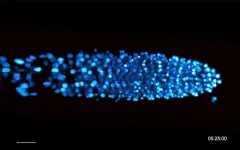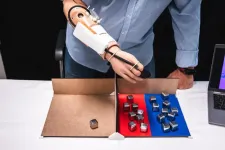(Press-News.org) Using single photons as qubits has become a prominent strategy in quantum information technology. Accurately determining the number of photons is crucial in various quantum systems, including quantum computation, quantum communication, and quantum metrology. Photon-number-resolving detectors (PNRDs) play a vital role in achieving this accuracy and have two main performance indicators: resolving fidelity, which measures the probability of accurately recording the number of incident photons, and dynamic range, which describes the maximum resolvable photon number.
Superconducting nanostrip single-photon detectors (SNSPDs) are considered the leading technology for single-photon detection. They offer near-perfect efficiency and high-speed performance. However, when it comes to photon-number resolution, SNSPD-based PNRDs have struggled to find a balance between fidelity and dynamic range. Existing array-style SNSPDs, which divide incident photons among a limited number of pixels, face fidelity constraints. These detectors are thus referred to as quasi-PNRDs.
SNSPDs operate by breaking the local superconductivity of a narrow, cooled, current-biased strip when a photon is absorbed. This creates a local resistive region called a hotspot, and the resulting current is diverted through a load resistor, generating a detectable voltage pulse. Therefore, an SNSPD with a sufficiently long superconducting strip can be seen as a cascade of thousands of elements, and n-photon simultaneously activating different elements should generate n non-overlapping hotspots. However, conventional SNSPDs combined with modified cryogenic readouts can only resolve 3-4 photon numbers, resulting in a low dynamic range.
As reported in Advanced Photonics, researchers from the Shanghai Institute of Microsystem and Information Technology (SIMIT), Chinese Academy of Sciences, have made progress in enhancing the photon-number-resolving capability of SNSPDs. By increasing the strip width or total inductance, they were able to overcome bandwidth limitations and timing jitter in readout electronics. This resulted in stretched rising edges and improved signal-to-noise ratio in the response pulses, and thus enhanced readout fidelity.
By widening the superconducting strip to micrometer scale, the researchers have presented the first observation of true-photon-number resolution up to 10 using the superconducting microstrip single-photon detector (SMSPD). Surprisingly, they achieved these results even without the use of cryogenic amplifiers. The readout fidelity reached an impressive 98 percent for 4-photon events and 90 percent for 6-photon events.
Furthermore, the researchers proposed a dual-channel timing setup to enable real-time photon-number readout. This approach significantly reduced data acquisition requirements by three orders of magnitude and simplified the readout setup. They also demonstrated the utility of their system in quantum information technology by creating a quantum random-number generator based on sampling the parity of a coherent state. This technology ensures unbiasedness, robustness against experimental imperfections and environmental noise, and resistance to eavesdropping.
This research represents a significant advancement in the field of PNRDs. With further improvement in the detection efficiency of SMSPDs, this technology could become readily accessible for various optical quantum information applications. These results highlight the potential of SNSPDs or SMSPDs for achieving high-fidelity and large-dynamic-range photon-number resolution.
For details, see the Gold Open Access article by Kong, Zhang et al., “Large-inductance superconducting microstrip photon detector enabling 10 photon-number resolution,” Adv. Photon. 6(1) 016004 (2024) doi 10.1117/1.AP.6.1.016004.
END
Unlocking quantum precision: Expanded superconducting strips for enhanced photon-counting accuracy
Wider superconducting strips enable better photon-number resolution, with greater dynamic range and fidelity
2024-02-09
ELSE PRESS RELEASES FROM THIS DATE:
From growing roots, clues to how stem cells decide their fate
2024-02-09
DURHAM, N.C. -- It might look like a comet or a shooting star, but this time-lapse video is actually a tiny plant root, not much thicker than a human hair, magnified hundreds of times as it grows under the microscope.
Researchers at Duke University have been making such movies by peering at stem cells near the root’s tip and taking snapshots as they divide and multiply over time, using a technique called light sheet microscopy.
The work offers more than a front row seat to the drama of growing roots. By watching how the cells divide in response to certain chemical signals, the team is finding new clues to how stem cells choose one ...
UK's Nursing’s Stanifer chosen as scholar in Environmental Health Research Institute for Nurse and Clinician Scientists
2024-02-09
LEXINGTON, Ky. (Feb. 8, 2024) — A researcher in the University of Kentucky College of Nursing has been selected as a scholar for the Environmental Health Research Institute for Nurse and Clinician Scientists (EHRI-NCS).
EHRI-NCS is a year-long flipped classroom, train-the-trainer and mentorship program aimed at developing a new era of environmental health nursing science. It’s led by Castner Incorporated, a health research company, in partnership with Emory University, Washington State University and University of Alabama in Huntsville.
Stacy Stanifer, Ph.D., an advanced practice registered nurse and an assistant professor of nursing, was selected to participate. ...
Protein accumulation on fat droplets implicated in late-onset Alzheimer’s disease
2024-02-09
CHAPEL HILL, N.C. – UNC School of Medicine researcher Sarah Cohen, PhD, and Ian Windham, a former PhD student from the Cohen lab, have made a new discovery about apolipoprotein E (APOE) – the biggest genetic risk factor for late-onset Alzheimer’s disease.
Older people who inherited a genetic variant called APOE4 from their parents have a two- or three-times greater risk of developing the late-onset neurodegenerative disease. If researchers can better understand how APOE4 is affecting brain cells, it may help them design effective therapeutics and target the mechanisms causing the enhanced disease risk.
Cohen and Windham performed an exceptionally ...
New strategy for safer CAR T cell therapy in lymphomas
2024-02-09
In the treatment of aggressive lymphomas and blood cancer (leukaemia), so-called chimeric antigen receptor T cells (CAR T cells) are increasingly being used. For this therapy, immune cells are taken from patients and programmed by means of genetic engineering to detect proteins on the malignant tumour cells. Back in the body, the CAR T cells then fight the cancer cells. Due to some heavy side effects, this therapy requires extreme caution and long hospital stays. Scientists at University Hospital Cologne are therefore researching ...
Mariana Mesel-Lemoine appointed as Director of Diversity, Equity and Inclusion at the Institut Pasteur
2024-02-09
Acting on a proposal from the Institut Pasteur President Yasmine Belkaid, the Institut Pasteur Board of Governors appointed Mariana Mesel-Lemoine as Director of Diversity, Equity and Inclusion on Wednesday February 7, 2024.
This appointment marks a significant milestone in the history of the Institut Pasteur, and it is the first French research institute to establish a position of this kind at such a senior and strategic level. Mariana Mesel-Lemoine will report directly to the President. Her mission will be to propose policy and strategy priorities related to diversity, equity and inclusion for the "Pasteur 2030" Strategic Plan, to oversee ...
Time to anticoagulation reversal and outcomes after intracerebral hemorrhage
2024-02-09
About The Study: In hospitals participating in Get With The Guidelines–Stroke, earlier anticoagulation reversal was associated with improved survival for patients with intracerebral hemorrhage. These findings support intensive efforts to accelerate evaluation and treatment for patients with this devastating form of stroke.
Authors: Kevin N. Sheth, M.D., of the Yale University School of Medicine in New Haven, Connecticut, is the corresponding author.
To access the embargoed study: Visit our For The Media website at this ...
Data shows significant prevalence of sleep apnea among cardio-oncology patients
2024-02-09
Sleep apnea is prevalent among cardio-oncology patients who are at higher risk for congestive heart failure from cancer therapy, according to a new study being presented at the American College of Cardiology (ACC) Advancing the Cardiovascular Care of the Oncology Patient course.
Sleep apnea is a disorder of altered breathing while asleep with two types, obstructive (OSA) or central (CSA). Both can be treated to alleviate symptoms and improve cardiovascular outcomes. This study pertains to obstructive sleep apnea. A well-established screening tool for detecting sleep apnea is the STOP-BANG questionnaire utilizing eight questions using ...
Emergence of SARS-CoV-2 variant JN.1 raises concerns with increased transmissibility and immune evasion
2024-02-09
Since December 2019, severe acute respiratory syndrome coronavirus 2 (SARS-CoV-2) has posed a worldwide threat. The emergence of the BA.2.86 variant, a subvariant of Omicron, has raised significant concerns due to its substantial number of mutations. Discovered in August 2023, this variant differs markedly from other existing types such as Omicron XBB (including EG.5.1 and HK.3). Compared with XBB and BA.2, BA.2.86 exhibits more than 30 mutations in its spike protein, contributing to its ability to effectively evade the immune system’s defenses.
Over ...
Temperature-sensitive prosthetic limb improves amputee dexterity and feelings of human connection
2024-02-09
Sensory feedback is important for amputees to be able to explore and interact with their environment. Now, researchers have developed a device that allows amputees to sense and respond to temperature by delivering thermal information from the prosthesis’ fingertip to the amputee’s residual limb. The “MiniTouch” device, presented February 9 in the journal Med, uses off-the-shelf electronics, can be integrated into commercially available prosthetic limbs, and does not require surgery. Using the thermally sensitive prosthetic hand, ...
Towards a natural prosthetic hand: A study published in Med has developed a temperature-sensitive prosthetic limb that improves amputee interactions and feelings of human connection
2024-02-09
Pisa, 9 February 2024. “When one of the researchers placed the sensor on his own body, I could feel the warmth of another person with my phantom hand. it was a very strong emotion for me, it was like reactivating a connection with someone”.
Thanks to a sensorised prosthetic hand that provides realistic and real-time thermal feedback, Fabrizio, a 57-year-old man from Pistoia with a transradial (wrist) amputation, was able to discriminate between and manually sort objects of different temperatures or materials and ...
LAST 30 PRESS RELEASES:
American College of Cardiology comments on new dietary guidelines for Americans
American Society of Gene & Cell Therapy and Orphan Therapeutics Accelerator partner to advance and commercialize promising rare disease treatments
One in 14 patients having day case surgery have new or worse chronic pain 3 months after their operation
New study highlights link between eviction rates and gun violence
Heatwaves heat up soil but not toxin levels in rice, study finds
Digital modeling reveals where construction carbon emissions really come from
Turning farm waste into water filters
New study shows how the spleen helps the immune system accept a transplant
New Mayo Clinic study advances personalized prostate cancer education with an EHR-integrated AI agent
Researchers identify novel therapeutic target to improve recovery after nerve injury
Microbes in breast milk help populate infant gut microbiomes
Reprogramming immunity to rewrite the story of Type 1 diabetes
New tool narrows the search for ideal material structures
Artificial saliva containing sugarcane protein helps protect the teeth of patients with head and neck cancer
Understanding the role of linear ubiquitination in T-tubule biogenesis
Researchers identify urban atmosphere as primary reservoir of microplastics
World’s oldest arrow poison – 60,000-year-old traces reveal early advanced hunting techniques
Bristol scientists discover early sponges were soft
New study uncovers how rice viruses manipulate plant defenses to protect insect vectors
NSF–DOE Vera C. Rubin Observatory spots record-breaking asteroid in pre-survey observations
Ribosomal engineering creates “super-probiotic” bacteria
This self-powered eye tracker harnesses energy from blinking and is as comfortable as everyday glasses
Adverse prenatal exposures linked to higher rates of mental health issues, brain changes in adolescents
Restoring mitochondria shows promise for treating chronic nerve pain
Nature study identifies a molecular switch that controls transitions between single-celled and multicellular forms
USU chemists' CRISPR discovery could lead to single diagnostic test for COVID, flu, RSV
Early hominins from Morocco reveal an African lineage near the root of Homo sapiens
Small chimps, big risks: What chimps show us about our own behavior
We finally know how the most common types of planets are created
Thirty-year risk of cardiovascular disease among healthy women according to clinical thresholds of lipoprotein(a)
[Press-News.org] Unlocking quantum precision: Expanded superconducting strips for enhanced photon-counting accuracyWider superconducting strips enable better photon-number resolution, with greater dynamic range and fidelity







